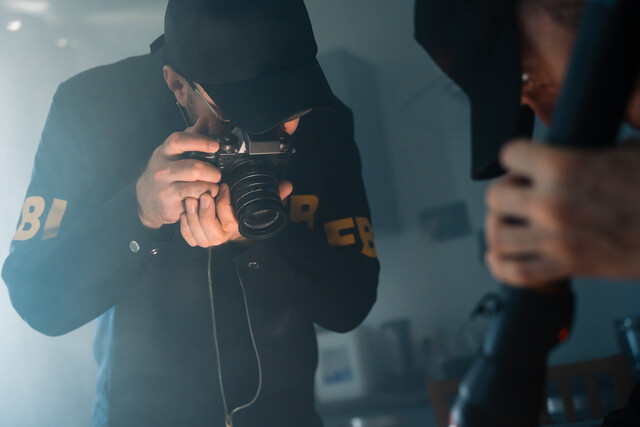Introduction
Do you know the difference between what you actually see and what you think you see?
One of the first mistakes that new crime scene investigators often make is that they often take a first look at the physical evidence present at a crime scene and then make leaps in conjecture as to what actually occurred there. It is important for all crime scene investigators to remain objective until the last possible piece of evidence is collected and analyzed. Does this mean he or she can't consider the possibilities? No. It just means that a crime scene investigator must never assume, or jump to conclusions to prevent an unconscious bias when it comes to seeking further evidence in the pursuit of justice.
The knowledge, skills and experience of a crime scene investigator and their team may very well establish guilt or innocence, and as such professionalism, integrity and ethics are vitally important to their role at any crime scene.
For example, the study of the victim, or victimology is an important component of crime scene analysis. It provides context and understanding in the process of interpreting a crime scene, especially those that are staged. This is often the case in murders, and is called an equivocal death investigation.
Victimology is vital in determining suspects as well as motives for any particular crime. It is the collection and evaluation of any and all important information regarding the victim, his or her habits and behaviors and lifestyle. This can include information about where the victim worked, their education level, reputation, personal relationships, and any history of alcohol or drug abuse. The question that all law enforcement personnel, including crime scene investigators inevitably ask when viewing a victim for the first time is, "Who was this person and what happened to bring about this event?"
The process of determining information about the victim and circumstances surrounding the death begin immediately. Crime scene investigators must not jump to conclusions based on what the victim is or is not wearing, the area in which they have been found, unless it is their home or place of business. It extends beyond the crime scene and delves into the personal life of the victim to the point that emails, telephone calls, messages, letters and personal browsing preferences on the Internet. In many cases where the victim is found in a home, this type of background information is readily available. By looking around a victim's home in many cases, a crime scene investigator can get a grasp of the lifestyle of a victim.
Several questions need to be answered:
- Who did it?
- What happened?
- Why did it happen?
The steps toward finding the answers lie not only in the physical evidence, but also in the life and background of the victim. That is why it is so extremely important for crime scene investigators to resist the temptation to take superficial appearances for granted. Many million-dollar homes hide drug-manufacturing paraphernalia, just as many downtrodden mobile home parks reveal hard-working and honest citizens.
There is a saying in law enforcement that has been ingrained into the mind of every young rookie, no matter his or her job specialty or placement:Things are not always what they appear to be.
Killers determined to lead investigators in the wrong direction stage many crime scenes. In many cases, murders, premeditated or not, are often disguised as rape-homicides. Often, killers often attempt to make the crime scene look like a suicide. These types of investigations are called equivocal death investigations. Such a crime scene is "open to interpretation", which means that there may be several possibilities of what has occurred there. Such deaths may look like an obvious suicide or homicide, or they may appear like natural or accidental deaths. There are three very common types of crime scene staging: - The perpetrator attempts to make the crime appear to be a random, sex-related homicide.
- The perpetrator deliberately alters the scene to make the murder appear to be a suicide or accident.
- Arson set to destroy evidence or make it appear as if the fire was accidental.
This is why victimology is so important during the process of any death investigation.
However, recall that many family members often attempt to "clean" a scene or otherwise move or attempt to clothe or protect a victim, especially in the case of a suicide. This is not deliberate "staging" on the part of whoever moved the body in most cases, but an instinctive desire to protect the dignity or reputation of the victim.
Many crime scene investigators, police officers and detectives react to suspicious deaths with what is called "gut instinct". Basically, if it looks like a duck, walks like a duck and quacks like a duck, it's a duck. While alerting the investigator that something is not what it seems to appear, a gut instinct should never result in a crime scene's investigator's normal investigative process. ALL the evidence must be collected, whether or not he or she believes the cause and manner of death is obvious.
Case Study
Police are summoned to the home of a man who reports that a shooting has occurred. The victim is a 25-year-old white woman, the man's friend. She had been watching his kids while he was out with friends. Police arrived at the scene to find the woman on a recliner chair in the man's living room, a gun in her right hand. The victim's thumb was still inside the trigger guard. She had suffered a gunshot wound to the left side of her nose and the exit wound was found in the upper part of the back of her head. An ejected shell casing was found roughly six feet away from the victim's chair. Upon closer examination of the wound, no contact evidence (i.e. soot or stippling) on the face or "blowback" (blood or other body tissues) was found on the gun.The man stated that the woman had asked to see his gun, and was in the process of examining it, turning it this way and that, when the gun went off and a bullet struck her in the face. A test for GSR (gunshot residue) to the hands of the male witness proved negative. The responding officers and their lieutenant, who was called to the scene, decided that the death was indeed accidental and did not call in detective.
It was only the following day, after closer examination of the crime scene photos, that homicide detectives reviewing the case noticed that the elements of the crime scene did not match the statements of the witness. They initiated an investigation. It was determined that the weapon had to have been fired at least 42 inches away from the victim to produce the type and edgings to the wound. In addition, spent shells had to be manually removed from the weapon.
Detectives returned to the scene and questioned the male witness as well as family and friends of the victim. It was soon determined that the male witness had a drinking problem, had been drinking heavily the night of the incident. Confronted with the information supplied by other witnesses, he admitted that he had been drinking, and had been showing off his weapon when it accidentally discharged, striking the woman in the face. He had tried to make the woman's death look like a suicide. Charged with murder, he was convicted of manslaughter.
There are several strategies and guidelines that crime scene investigators can follow in order to assure that all the bases have been covered:
1.) Determine the victimology.
2.) Assess injuries and wounds and if possible, determine type of weapon used in the crime.
3.) Follow procedure and process, collect and evaluate all the physical evidence.
4.) Inspect and evaluate possible weapons.
5.) Assess behavior of any suspects, as well as recent movements and attitudes of the victim, if possible.
6.) Speak to family and friends and create a well-rounded profile of the victim.
7.) Attempt to reconstruct and assess the circumstances surrounding the death event.
8.) Compare visual, physical evidence findings with findings on autopsy and laboratory test results.
9.) Corroborate, whenever possible, all statements by family, friends and suspects with proven fact.
-
Conclusion
-
It is wise for the crime scene investigator to always approach any death scene as if it were a homicide scene. In using such an approach, suppositions and guesswork will not lead investigators down the wrong investigative road. Law enforcement personnel, crime scene investigators and technicians must always approach a crime scene with professionalism and thoroughness.

























